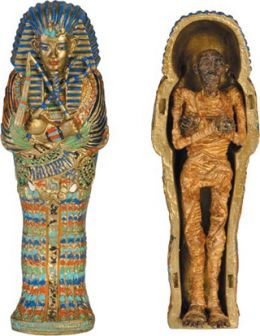
It was like ‘being at rest,’ likened to sleep, “the night of going forth to life.” While sleeping, one is alive. Paul Getty Trustĭeath, for the ancient Egyptians, wasn’t the end, but a transition. Left, he embraces Osiris, followed by his own ka, wearing the upraised arms ? hieroglyph for ‘ka’.

Right, Ay performs the ‘opening of the mouth’ on Tut’s mummy. How Life Was Given To Ancient Egyptian Mummies Tutankhamun‘s mummy given life. Otherwise, it would be a “second death.” To ensure eternal life, the body had to be perfectly preserved, remain identifiable, and be given the ability to breathe. The ba left and returned at night, but needed to recognize its own mummy. Lastly, the soul, which could travel, the ba.Īll the spiritual elements needed the body as a haven for eternity. Then, one’s life force and spiritual twin, the ka. Then, always attached to the body, a shadow. A person was made of different elements, starting with the body. Therefore, they built for eternity.īody and soul had to be preserved as a condition for eternal life. To them, it meant vanquishing death by being perpetually reborn. To us, mummies and monumental tombs imply a morbid fascination with death. Burying the dead in a land that was constantly revived meant they could benefit from this everlasting rebirth cycle. Please check your inbox to activate your subscription Thank you!Įgypt, they thought, was blessed with a divine and harmonious mechanism of life. Every night, the stars moved, like the sun and Nile, in an orderly fashion. Once a year, the Nile spread and transformed barren ground into fertile land. Watching the sun dying at night, only to be reborn each morning. They came to this notion from observing the world around them and concluded that it was in perpetual rebirth. The ancient Egyptians believed the dead would resurrect and live forever. The Afterlife In Ancient Egypt Mummy coffins, the gilded coffin of Henutmehyt, coffin of Hornedjitef coffin of an unknown man wearing the Roman civic costume complete painted Fayum portrait and mummy of Artemidorus. Why was it so important that the body’s features endured in the afterlife?

A salt-like mineral, natron, was used to dry corpses to ensure they remained intact. These were the foundations of the ancient Egyptian civilization’s quest for eternal life.įive millennia ago, the process of drying corpses became artificial.

They placed pots and daily life items next to the dead and buried them in a fetal position, as if they expected they would be reborn. Over six thousand years ago, the ancient Egyptians realized the hot desert sand naturally preserved corpses. From naturally dried bodies, to plastered corpses, the mummified face of Governor Djehutynakht and a complete Fayum mummy portrait. Before The Fayum Portraits, Millennia Of Mummification Four millennia of mummification.


 0 kommentar(er)
0 kommentar(er)
